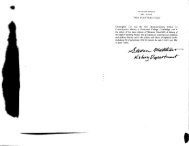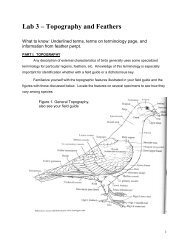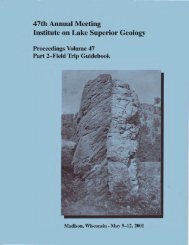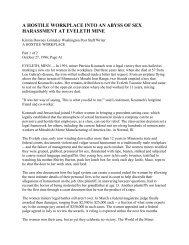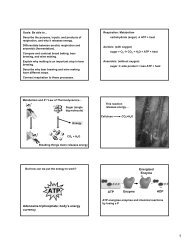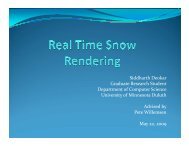Petrology and Cu-Ni-PGE Mineralization of the Bovine Igneous ...
Petrology and Cu-Ni-PGE Mineralization of the Bovine Igneous ...
Petrology and Cu-Ni-PGE Mineralization of the Bovine Igneous ...
You also want an ePaper? Increase the reach of your titles
YUMPU automatically turns print PDFs into web optimized ePapers that Google loves.
localized gabbroic oxide anorthosites (Fig. 18). As observed in core BIC01-01, localized<br />
intervals <strong>of</strong> gabbroic anorthosite seem to be intimately associated with zones <strong>of</strong> extreme<br />
epidote-sericite-carbonate alteration. The oxide gabbro unit contains 50 to 70% lath-shaped<br />
plagioclase <strong>and</strong> 15 to 25% subhedral granular augite (Fig. 26B). Olivine is no longer present at<br />
this level in <strong>the</strong> intrusion. Amphibole <strong>and</strong> biotite are only present in trace amounts. Plagioclase<br />
<strong>and</strong> augite range from moderately to strongly altered to sericite <strong>and</strong> uralite, respectively.<br />
The mineralogic, textural <strong>and</strong> alteration attributes <strong>of</strong> <strong>the</strong> oxide gabbro, feldspathic oxide<br />
clinopyroxenite, upper feldspathic olivine clinopyroxenite, <strong>and</strong> upper feldspathic wehrlite<br />
stratigraphic units from drill core 08BIC044 are generally similar to <strong>the</strong> same units identified<br />
in drill core BIC01-01 <strong>and</strong> <strong>the</strong> units described in field mapping. Based on <strong>the</strong>se similarities, it<br />
is reasonable to conclude that <strong>the</strong>se four units directly correlate with one ano<strong>the</strong>r. The<br />
feldspathic olivine clinopyroxenite <strong>and</strong> feldspathic wehrlite that occur in <strong>the</strong> lower part <strong>of</strong> drill<br />
core 08BIC044, although sharing generally comparable lithologies with <strong>the</strong> upper units <strong>of</strong> <strong>the</strong><br />
same name, clearly constitute a distinct package <strong>of</strong> ultramafic rocks. Therefore, to formalize<br />
<strong>the</strong> distinction between <strong>the</strong> two sequences <strong>of</strong> ultramafic rocks <strong>and</strong> to distinguish <strong>the</strong> ultramafic<br />
<strong>and</strong> gabbroic rocks observed in drill core <strong>and</strong> in outcrop, <strong>the</strong> BIC will be hereafter subdivided<br />
into three major zones: <strong>the</strong> Lower Ultramafic Zone (LUZ), <strong>the</strong> Upper Ultramafic zone (UUZ),<br />
<strong>and</strong> <strong>the</strong> Gabbro Zone (GZ) (Figs. 17, 19, <strong>and</strong> 20). The Lower Ultramafic Zone is composed <strong>of</strong><br />
<strong>the</strong> lower wehrlite unit <strong>and</strong> <strong>the</strong> lower clinopyroxenite unit. The Upper Ultramafic Zone is<br />
made up <strong>of</strong> <strong>the</strong> upper wehrlite, upper clinopyroxenite, <strong>and</strong> oxide clinopyroxenite units. Finally<br />
<strong>the</strong> Gabbro Zone is comprised <strong>of</strong> <strong>the</strong> oxide gabbro unit.<br />
39




